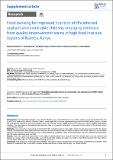| dc.contributor.author | Akulima, Muhamed | |
| dc.contributor.author | Ikamati, Rudia | |
| dc.contributor.author | Mungai, Margaret | |
| dc.contributor.author | Samuel, Muhula | |
| dc.contributor.author | Ndirangu, Meshack | |
| dc.contributor.author | Muga, Richard | |
| dc.date.accessioned | 2021-08-21T13:22:03Z | |
| dc.date.available | 2021-08-21T13:22:03Z | |
| dc.date.issued | 11/26/2016 | |
| dc.identifier.citation | Akulima M, Ikamati R, Mungai M, Samuel M, Ndirangu M, Muga R. Food banking for improved nutrition of HIV infected orphans and vulnerable children; emerging evidence from quality improvement teams in high food insecure regions of Kiambu, Kenya. Pan Afr Med J. 2016 Nov 26;25(Suppl 2):4. doi: 10.11604/pamj.supp.2016.25.2.9663. PMID: 28439329; PMCID: PMC5390061. | en_US |
| dc.identifier.issn | 1937-8688. | |
| dc.identifier.uri | http://repository.amref.org/handle/123456789/124 | |
| dc.description | © Muhamed Akulima et al. The Pan African Medical Journal - ISSN 1937-8688. This is an Open Access article distributed under the terms of the Creative Commons
Attribution License (http://creativecommons.org/licenses/by/2.0), which permits unrestricted use, distribution, and reproduction in any medium, provided the original
work is properly cited. | en_US |
| dc.description.abstract | Introduction: Estimated 236,548 People Living with HIV (PLHIV) were in Central-Eastern Kenya in 2013. Kiambu County had 46,656 PLHIV with 42,400 (91%) adults and 4,200(9%) children (1-14yrs). Amref Health Africa in Kenya, supported through USAID-APHIAplus KAMILI project, initiated two food banks to respond to poor nutritional status of the HIV infected children. Quality Improvement Teams were used to facilitate food-banking initiatives. The study aimed at assessing and demonstrating roles of community food-banking in improving nutrition status of HIV-infected children in food insecure regions.
Methods: A pre and post-test study lasting 12 months (Oct 2013 to September 2014) conducted in Kiambu County, Kenya covering 103 HIV infected children. Two assessments were conducted before and after the food banking initiative and results compared. Child Status Index (CSI) and the Middle Upper Arm Circumference (MUAC) tools were used in data collection at households. Paired T-test and Wilcoxon test were applied for analysing MUAC and CSI scores respectively using the SPSS.
Results: There was a significant improvement in the children's nutrition status from a rating of 'bad' in CSI Median (IQR) score 2(2-1) before food banking to a rating of 'fair' in CSI Median (IQR) score 3(4-3) after food banking intervention (p=<0.001) while MUAC increased from Mean (SD) of 5.6(2.6) before intervention to 7.2(2.8) after food banking (p=<0.001).
Conclusion: Food banking is a community-based nutritional intervention that can address factors of food access, affordability and availability. Food banking is a sustainable way to contribute to quality nutrition and reduced related deaths among HIV infected children. | en_US |
| dc.language.iso | en | en_US |
| dc.publisher | Pan African Medical Journal | en_US |
| dc.subject | Child Status Index | en_US |
| dc.subject | Community | en_US |
| dc.subject | HIV-infected Orphans | en_US |
| dc.subject | Middle Upper Arm Circumference | en_US |
| dc.subject | Food banking | en_US |
| dc.subject | Quality improvement | en_US |
| dc.subject | Vulnerable children | en_US |
| dc.title | Food Banking for Improved Nutrition of HIV Infected Orphans and Vulnerable Children; Emerging Evidence from Quality Improvement Teams in High Food Insecure Regions of Kiambu, Kenya | en_US |
| dc.type | Article, Journal | en_US |

